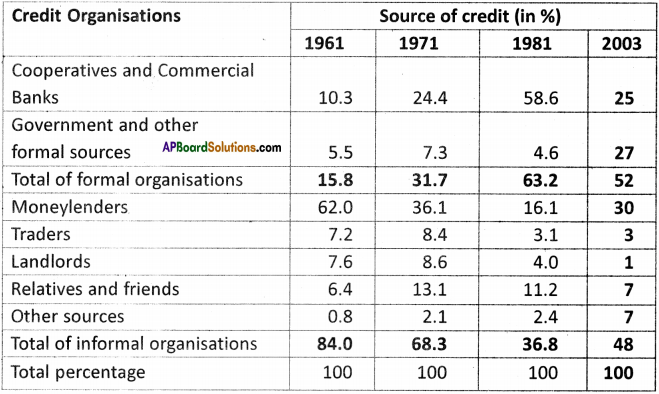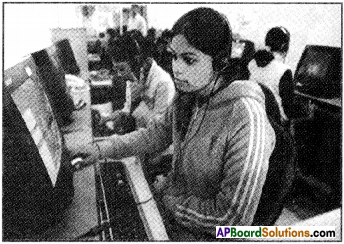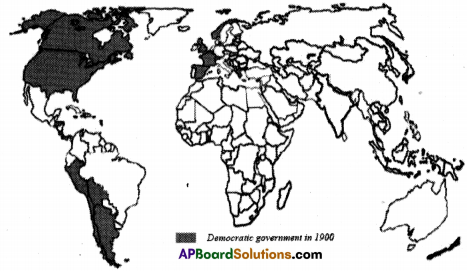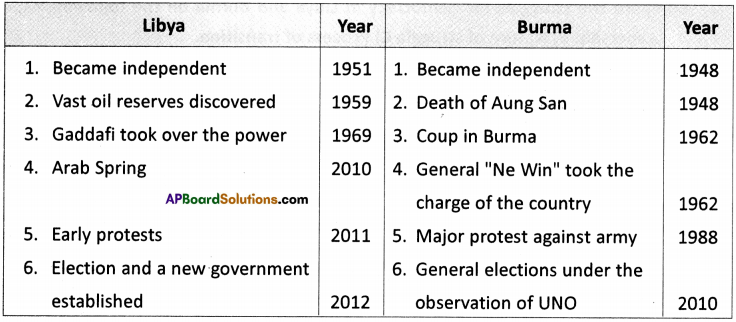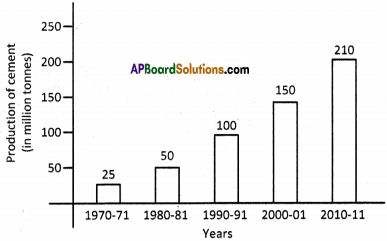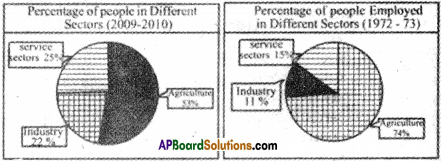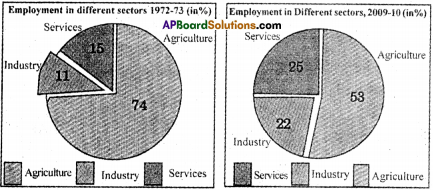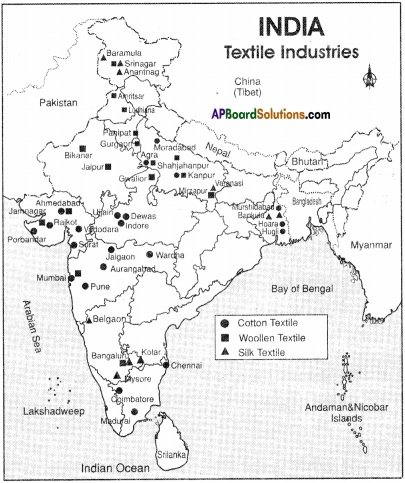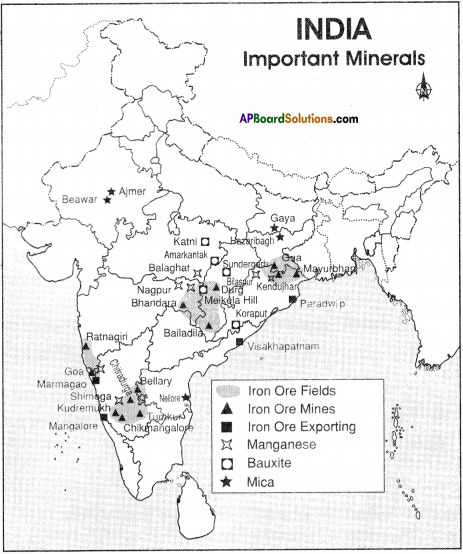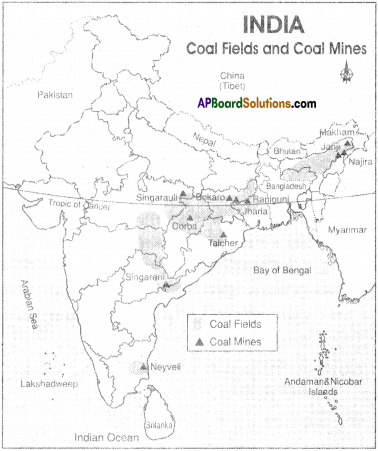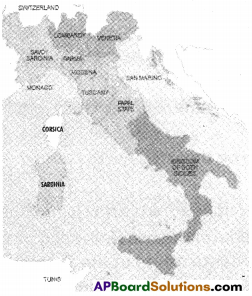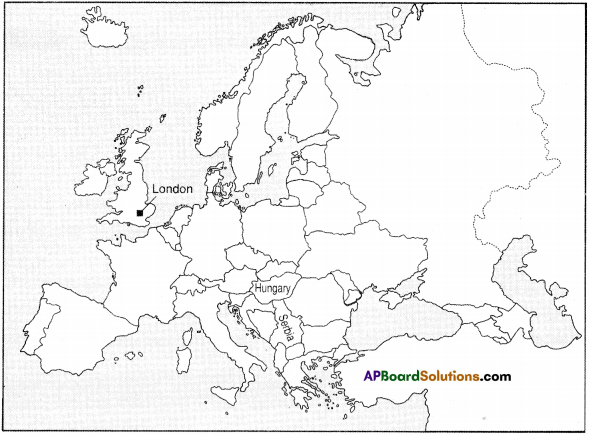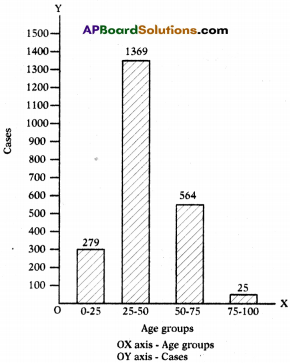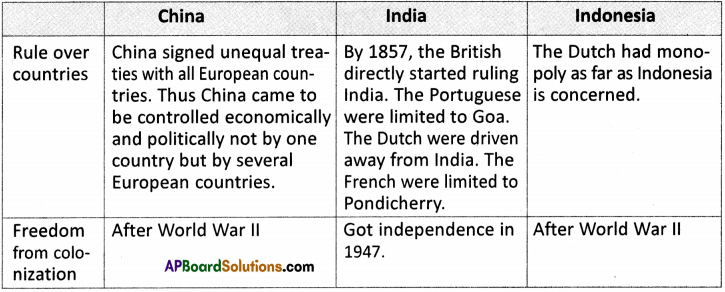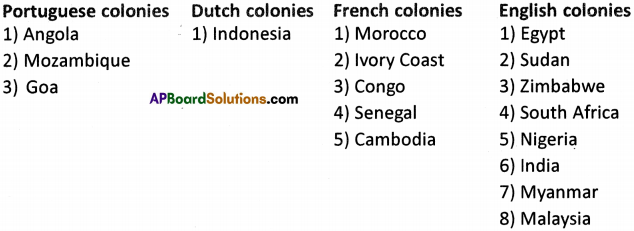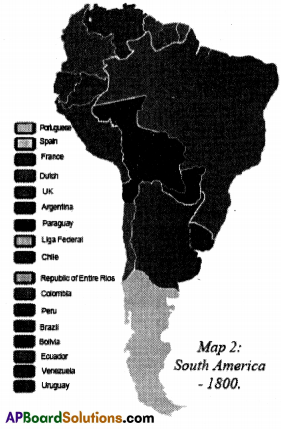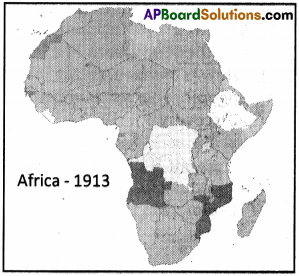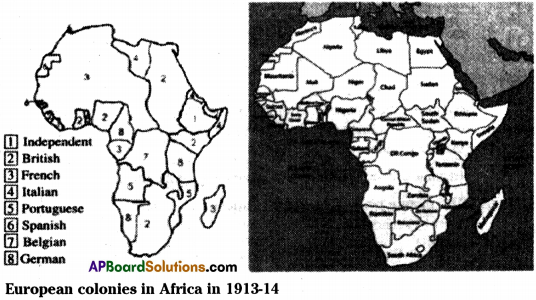AP State Syllabus AP Board 9th Class Social Studies Important Questions Chapter 15 Industrialisation and Social Change.
AP State Syllabus 9th Class Social Studies Important Questions 15th Lesson Industrialisation and Social Change
9th Class Social 15th Lesson Industrialisation and Social Change 1 Mark Important Questions and Answers
Question 1.
In what way did Canal Transportation aid Industrial Revolution? (SA-I : 2019-20)
Answer:
Canals were the answer to moving heavy objects to large distances
9th Class Social 15th Lesson Industrialisation and Social Change 2 Marks Important Questions and Answers
Question 2.
Why did modem industrialisatfon first occured in Britain only? (SA-III : 2016-17)
(OR)
Why do you think Britain was the first country to Industrialize?
Answer:
- Britain was blessed with modest climate to suit cotton industry.
- There was no scarcity of power.
- There was availability of sufficient raw material.
- Coal and Iron were available in abundance side by side.
- It was convenient to transport the raw material by water.
- There was no dearth of capital and Bank of England was also helpful in raising capital.
- Workers were available in large numbers.
- It was ready to sea trade with a large number of ports.

Question 2.
20th century inventions were hugely influenced by major developments in technology and resources, enabling the inventions of key items and devices which changed the way we live today.
Mention any two inventions one each in transportation and medicine and mention briefly how they changed the way we live today. (SA-II : 2018-19)
Answer:
Transportation :
Aeroplanes, Motor vehicles, Railways, etc.
Medicine:
Anti-biotics, vaccines, chloroforms, Anti-virus, etc. Now-a-days world become a big village by a fastest means of transport. Even long distance also reached in a short time. Due to medicines, the life expectancy of human being is increased.
9th Class Social 15th Lesson Industrialisation and Social Change 4 Marks Important Questions and Answers
Question 1.
The road-builder John Metacalf, who personally surveyed surfaces for roads and planned them, was blind. The canal builder James Brindley was almost illiterate, with such poor spelling that he could never spell the word ‘navigation’, but he had tremendous powers of memory, imagination and concentration.
Read the paragraph given above and comment on that. (SA-III : 2016-17)
Answer:
According to the above para, if we want to invent a new thing we need more determination, interest, curiosity, even luck, than the application of scientific knowledge. Along with the above, memory, imagination, and concentration also need.

Question 2.
“Good transportation facilities leads to rapid industrialization” – Justify the statement. (SA-I : 2018-19)
Answer:
- Transport system really helps the industry.
- Without transportation, the products made by the industry cannot be sold in distant places.
- The industry has a particular transport system to send their products to places and sell them for profit.
- Without proper transport system, there is risk of damage of products.
- The invention of steam engine reduced the cost of transportation.
- Development of aircraft was useful for fastest means of transport.
- Good transport system leads to rapid industrialization.
Question 3.
Mobile phone – Internet – Computers – Airways
Choose any TWO of the inventions listed above Explain how they changed people’s lives. (SA-I : 2019-20)
Answer:
Mobile Phone:
- Mobile phones have completely changed the way people interact.
- Today, the mobile phone has become part and parcel of many people’s lives.
- You can call, send text messages, read emails, play games as well as read and edit documents.
- Through mobile phone, we can send money quickly to others who are in need.
- It create new market places.
- It help people find jobs.
- It help the farmers to get weather information.
Internet:
- The Internet creates new ways for us to communicate, work and share information.
- The main advantage of the internet is it ability to connect billions of computers and devices to each other.
- By it, we get more information.
- Enjoy virtual field trips.
- It creates assignment convenience and flexibility.
Computer:
- It act as highly reliable scientific equipment.
- They receive and store data and carries out logical and mathematical calculations too to provide fast and accurate results.
- It can store more data.
Airways :
- Through air ways we can reach our destination quickly.
- It transports people, goods, the military equipment around the world.
- It is the fastest means of transport.
- During the time of floods and calamities we can use more airways only to reach the place.
- It is supported to go to remote areas.
- It creates convenience to passengers.

Question 4.
Explain how the condition of the workers steadily declined in the early twentieth century Europe. (SA-I : 2019-20)
Answer:
Conditions of the worker.
1. The aboudance of labour in the market affected.
2. Seasonality of work :
It meant prolonged periods without work.
3. Low Real wages :
Wages are very low.
4. Poverty and Unemployment:
At the mid of 19th century, about 10 percent of Urban population was extremely poor.
The Unemployment rate was very high.
9th Class Social 15th Lesson Industrialisation and Social Change Important Questions and Answers
Question 1.
What is called ‘First Industrial Revolution?
Answer:
The transformation of industry and the economy in Britain between the 1780s and the 1850s is called the “First Industrial Revolution.”
Question 2.
Who used the term ‘Industrial Revolution’?
Answer:
The term ‘Industrial Revolution’ was used by European scholars – Georges Michelet in France and Friedrich Engels in Germany. It was used for the first time in English by the philosopher and economist Arnold Toynbee (1852-83), to describe the changes that occurred in British industrial development between 1760 and 1820.

Question 3.
What were the two main features of cotton industry?
Answer:
From the 1780s, the cotton industry symbolised British industrialisation in many ways. This industry had two features which were also seen in other industries. Raw cotton had to be entirely imported and a large part of the finished cloth was exported to other countries. Britain had its control over the sources of raw cotton as well as the markets. Where they sold cloth. This helped to increase its control over the colonies.
Question 4.
What was the new power source in England?
Answer:
Steam
Question 5.
Which country experienced modern industrialisation for the first time?
Answer:
Britain experienced modern industrialisation for the first time.
Question 6.
Name any bank in England.
Answer:
The Bank of England.
Question 7.
Who were used in coal mines to reach deep coal faces?
Answer:
Children were used in coal mines to reach deep coal faces.

Question 8.
Which countries lacked colonial resources?
Answer:
Germany and France lacked colonial resources.
Question 9.
What is Industrial revolution? Who coined this name?
Answer:
- The economy and industries in Britain changed completely between 1780s and 1850s.
- This phase is known as ‘First Industrial Revolution’.
- The term ‘Industrial Revolution’ was used by European Scholars George Michelet in France and Fredrich Engels in Germany.
- It was used for the first time in English by the Philosopher and economist Arnold Tonybee.
Question 10.
What do you know about the picture?

Answer:
This was the Cast Iron Bridge. It was near Coalbrookdale. It was designed by the third Darby.
Question 11.
What was it? How did it look like?
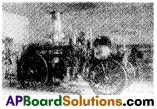
Answer:
This was James Watt’s steam engine. It was just looking like our present day tractor.
Question 12.
Compare the effects of the coming of the railways in different countries in the world.
Answer:
- The first steam locomotive, Stephenson’s Rocket, appeared in 1814. Railways emerged as a new means of transportation that was available throughout the year, both cheap and fast, to carry passengers and goods.
- They combined two inventions, the iron track which replaced the wooden track in the 1760s, and haulage along it by steam engine.
- The invention of the railways took the entire process of industrialisation to a second stage.
- The first railway line connected the cities of Stockton and Darlington in 1825, a distance of 9 miles that was completed in two hours at speeds of up to 24 kph (15 mph).
- The next railway line connected Liverpool and Manchester in 1830. Within 20 years, speeds of 30 to 50 miles an hour were usual.
Britain :
The railways changed British Society in numerous ways. It is nonetheless clear that the railways had a sizeable impact in many spheres of economic activity and daily life of the people.
Canada :
In Canada, the national government strongly supported railway construction for political goals.
India :
India provides an example of the British empire pouring its money into a very well built system designed for military reasons and with the hope that it would stimulate industry. The system was over built and much too elaborate and expensive for the small amount of freight traffic it carried.
Belgium :
Belgium took the lead in Industrial revolution on the continent starting in the 1820s. It provided an ideal model for showing the value of the railways for speeding the industrial revolution.
France:
In France, railways became a national medium for the modernisation of backward regions. Although starting the whole system at once was politically expedient, it delayed completion and forced even more reliance and temporary experts brought in from Britain.
Germany:
The take-off stage of economic development came with the railroad revolution in the 1840s. As a means of national defence, it facilitates the concentration, distributional direction of the army. It is a means to the improvement of the culture of the nation.
Russians:
It was Americans who brought the technology of railway construction to Russia in 1842. Russia was in need of big transportation system and geographically suited to railroads.
Thus the railways in different countries helped the industrial revolution in transportation.

Question 13.
Read the following passages and answer the given questions.
The Krupp Family
The Krupp family established what was going to become the world’s largest arms factory. This first factory specialised in field gun manufacture and, by 1887, it supplied arms to forty six different countries.
During World War I the Krupp factories made guns for the German artillery.
The Krupps supported Hitler in the German general election of 1933. As Nazi Germany occupied neighbouring countries, Alfred Krupp seized new land to make more factories. Many of these factories used slave-labour from the Nazi concentration camps.
1) What was the name of the family?
Answer:
The ’Krupp’ family.
2) What was the first factory?
Answer:
Gun manufacturing factory.
3) Which World War was mentioned here?
Answer:
First World War.
4) Whom did the Krupps support?
Answer:
The Krupps supported Hitler in the German general election of 1933.
5) Who were the workers in the factories?
Answer:
The slave – labour from the Nazi concentration camps.
Question 14.
Read the following passages and answer the given questions.
Steam power was first used in mining industries. As the demand for coal and metals expanded, efforts to obtain them from ever-deeper mines intensified. Flooding in mines was a serious problem and steam engines were used to drain the mines. But the technology was still very imperfect to be used on a large scale.
James Watt’s (1736-1819) invention converted the steam engine from being a mere pump into a ‘prime mover’ capable of providing energy to power machines in factories. Backed by the wealthy manufacturer Matthew Boulton (1728-1809), Watt created the Soho Foundry in Birmingham in 1775. From this foundry James Watt’s steam engines were produced in steadily growing numbers. By the end of the eighteenth century, Watt’s steam engine was beginning to replace hydraulic power. In 1840, British steam engines were generating more than 70 per cent of all European power.
1) Which power was first used in mining industries?
Answer:
Steam power
2) What was a serious problem?
Answer:
Flooding in mines was a serious problem.
3) Who was the wealthy manufacturer?
Answer:
Matthew Boulton.
4) In which foundry were the Watt’s engines produced?
Answer:
In Soho Foundry in Birmingham.
5) Appreciate the British steam engines.
Answer:
In 1840, British steam engines were generating more than 70% of all European power.

Question 15.
Read the following passages and answer the given questions.
Transportation
The need to transport raw materials and manufactured products led to the improvement of roads and the digging of canals in England. Me Adam devised the method of making ‘pakka’ or ‘macadamamised’ roads.
Canals were initially built to transport coal to cities. This was because the bulk and v/eight of coal made its transport by road much slower and more expensive than by barges on canals. The demand for coal, as industrial energy and for heating and lighting homes in cities, grew constantly. The making of the first English canal, the Worsley Canal (1761) by James Brindley (1716-72), had no other purpose than to carry coal from the coal deposits at Worsley (near Manchester) to that city. After the canal was completed the price of coal fell by half. Thousands of kilometres of canals were built by 1830 and were used to transport commodities cheaply. They were mostly built by landowners to enhance the value of their properties.
1) Which led to the improvement of roads and the digging of canals in England?
Answer:
The need to transport raw materials and manufactured products led to the improvement of roads and the digging of canals in England.
2) Which were initially built?
Answer:
Canals were initially built to transport.
3) Which grew constantly?
Answer:
The demand for coal, as industrial energy and for heating and lighting homes in cities, grew constantly.
4) What is the name of first English canal?
Answer:
Worsley Canal.
5) What was the interest of land owners in building the first canal?
Answer:
They were interested in enhancing the values of their properties.
6) Who built this canal?
Answer:
James Brindley.
Question 16.
Observe the following picture and answer the given questions.
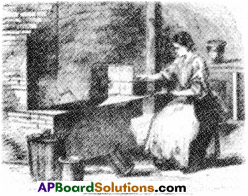
Woman in gilt-button factory, Birmingham. In the 1850s, two thirds of the workforce in the button trade was women and children. Men received 25 shillings a week, women 7 shillings and children one shilling each, for the same hours of work.
1) Who was she?
Answer:
She was a woman in gilt-button factory.
2) Where was the factory?
Answer:
It was in Birmingham.
3) Which year did the picture belonged to?
Answer:
It belonged to the 1850s.
4) What were the earnings of the workers?
Answer:
Men – 25 shillings a week
Women – 07 shillings a week
Children – 01 shilling a week
5) Is there any difference in the working time?
A. No, it was equal to all.

Question 17.
Read the following passages and answer the questions given below.
The Workers
A survey in 1842 revealed that the average lifespan of workers was lower than that of any other social group in cities: it was 15 years in Birmingham, 17 in Manchester, 21 in Derby. More people died, and died at a younger age, in the new industrial cities, than in the villages they had come from. Half the children failed to survive beyond the age of five. The increase in the population of cities was because of immigrants, rather than by an increase in the number of children born to families who already lived there.
Deaths were primarily caused by epidemics of disease that sprang from the pollution of water, like cholera and typhoid, or of the air, like tuberculosis. More than 31,000 people died from an outbreak of cholera in 1832. Until late in the nineteenth century, municipal authorities were negligent in attending to these dangerous conditions of life. The medical knowledge to understand and cure these diseases was unknown.
1) When was the survey conducted?
Answer:
In 1842.
2) What was the average lifespan?
Answer:
It was 15 years in Birhingham, 17 in Manchester, and 21 in Derby.
3) What was the cause of the increase in population?
Answer:
The increase in the population of cities was because of immigrants, rather than by an increase in the number of children born to families who already lived there.
4) What are the diseases mentioned here?
Answer:
Cholera, Typhoid, and Tuberculosis.
5) Why were the municipal authorities negligent in attending to these diseases?
Answer:
The medical knowledge to understand and cure these diseases was unknown.

Question 18.
Read the lesson and prepare any four questions relating to it.
Answer:
- How can we say that England was fortunate?
- What was the serious problem in mines?
- Whom was the first locomotive connected to?
- Why did the Krupp family establish the world’s largest arms factory?
Question 19.
What were the relative advantages of canal and railway transportation?
Answer:
- Both were used to transport commodities cheaply.
- Both enhanced the values of the properties.
- The invention and usage took the entire process of industrialisation to a second stage.
- Both reduced the time taken to travel between two places.
Question 20.
Why was Britain the first country to experience modern industrialisation?
Answer:
Reasons:
- Political stability
- Modest climate
- Availability of continuous water power
- Transportation facilities
- Abundant wealth
- Availability of labour
- Invention of machinery.
Question 21.
Write the favourable conditions which helped the inventions.
Answer:
It is interesting to read about the individuals who brought about these changes during industralisation. Few of them were trained scientists. Education in basic sciences like physics or chemistry was extremely limited until the late nineteenth century, even after the technological inventions described above. Since these inventions did not require a full knowledge of the laws of physics or chemistry on which they were based, advances in science could be and were made by brilliant, intuitive thinkers and persistent experimenters.
They were helped by the fact that England had certain features which other European countries did not. Dozens of scientific journals and published papers of scientific societies appeared in England between 1760 and 1800. There was a widespread thirst for knowledge even in the smaller towns. This was met by the activities of the Society of Arts (founded in 1754), by travelling lecturers, or in ‘coffee houses’ that multiplied through the eighteenth century.

Question 22.
Appreciate the efforts of German to become an Industrialised state.
Answer:
- Germany (erstwhile Prussia) exploited its rich coal fields (Silesia and Rhineland – the Rhur) and iron deposits (Bohemia) to flourish in steel industry.
- With the invention of electric dynamo, they lead electric industry in the world.
- Unification in 1871 made access to iron from Lorraine fields of iron from France.
- Government encouraged industry by providing road/rail transports and markets also.
- It also focused on arnament industry.
- Large banks provided the capital needed.
- By the beginning of 20th century, Germany had developed a powerful industrial base.
![]()
![]()

